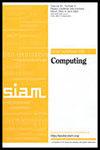Stronger 3-SUM Lower Bounds for Approximate Distance Oracles via Additive Combinatorics
IF 1.6
3区 计算机科学
Q3 COMPUTER SCIENCE, THEORY & METHODS
引用次数: 0
Abstract
SIAM Journal on Computing, Ahead of Print.Abstract. The “short cycle removal” technique was recently introduced by Abboud et al. [Proceedings of the 54th Annual ACM SIGACT Symposium on Theory of Computing, ACM, 2022, pp. 1487–1500] to prove the fine-grained hardness of approximation. Its main technical result is that listing all triangles in an [math]-regular graph is [math]-hard even when the number of short cycles is small, namely, when the number of [math]-cycles is [math] for [math]. Its corollaries are based on the 3-SUM conjecture and their strength depends on [math], i.e., on how effectively the short cycles are removed. Abboud et al. achieve [math] by applying structure versus randomness arguments on graphs. In this paper, we take a step back and apply conceptually similar arguments on the numbers of the 3-SUM problem, from which the hardness of triangle listing is derived. Consequently, we achieve [math] and the following lower bound corollaries under the 3-SUM conjecture: Approximate distance oracles: The seminal Thorup–Zwick distance oracles achieve stretch [math] after preprocessing a graph in [math] time. For the same stretch, and assuming the query time is [math], Abboud et al. proved an [math] lower bound on the preprocessing time; we improve it to [math], which is only a factor 2 away from the upper bound. Additionally, we obtain tight bounds for stretch [math] and [math] and higher lower bounds for dynamic shortest paths. Listing 4-cycles: Abboud et al. proved the first superlinear lower bound for listing all 4-cycles in a graph, ruling out [math] time algorithms where [math] is the number of 4-cycles. We settle the complexity of this basic problem by showing that the [math] upper bound is tight up to [math] factors. Our results exploit a rich tool set from additive combinatorics, most notably the Balog–Szemerédi–Gowers theorem and Rusza’s covering lemma. A key ingredient that may be of independent interest is a truly subquadratic algorithm for 3-SUM if one of the sets has small doubling.
通过加法组合论实现近似距离奥秘的更强 3-SUM 下界
SIAM 计算期刊》,提前印刷。 摘要Abboud 等人最近提出了 "短周期去除 "技术[Proceedings of the 54th Annual ACM SIGACT Symposium on Theory of Computing, ACM, 2022, pp.它的主要技术结果是,即使短循环的数量很少,即当[math]循环的数量为[math]时,列出[math]规则图中的所有三角形也是[math]难的。它的推论基于 3-SUM 猜想,其强度取决于 [math],即短周期被移除的有效程度。Abboud 等人通过在图上应用结构与随机性论证实现了 [math]。在本文中,我们退一步,将概念上类似的论证应用于 3-SUM 问题的数字上,并由此推导出三角形列表的难度。因此,我们实现了 [math] 和 3-SUM 猜想下的以下下界推论:近似距离神谕:开创性的 Thorup-Zwick 距离算子在[math]时间内对图进行预处理后实现了拉伸[math]。对于同样的拉伸,假设查询时间为[math],阿布德等人证明了预处理时间的[math]下界;我们将其改进为[math],与上界只相差 2 倍。此外,我们还获得了拉伸 [math] 和 [math] 的紧约束,以及动态最短路径的更高下限。列出 4 循环:Abboud 等人首次证明了列出图中所有 4 循环的超线性下界,排除了[math]时间算法,其中[math]是 4 循环的数量。我们通过证明[math]上界在[math]因子以内都很紧凑,解决了这一基本问题的复杂性。我们的结果利用了加法组合论中丰富的工具集,其中最著名的是巴洛格-塞梅雷迪-高尔斯定理和鲁萨覆盖稃。如果其中一个集合的倍率较小,3-SUM 的真正亚二次方算法就是一个可能引起独立兴趣的关键要素。
本文章由计算机程序翻译,如有差异,请以英文原文为准。
求助全文
约1分钟内获得全文
求助全文
来源期刊

SIAM Journal on Computing
工程技术-计算机:理论方法
CiteScore
4.60
自引率
0.00%
发文量
68
审稿时长
6-12 weeks
期刊介绍:
The SIAM Journal on Computing aims to provide coverage of the most significant work going on in the mathematical and formal aspects of computer science and nonnumerical computing. Submissions must be clearly written and make a significant technical contribution. Topics include but are not limited to analysis and design of algorithms, algorithmic game theory, data structures, computational complexity, computational algebra, computational aspects of combinatorics and graph theory, computational biology, computational geometry, computational robotics, the mathematical aspects of programming languages, artificial intelligence, computational learning, databases, information retrieval, cryptography, networks, distributed computing, parallel algorithms, and computer architecture.
 求助内容:
求助内容: 应助结果提醒方式:
应助结果提醒方式:


